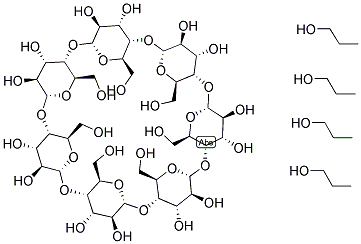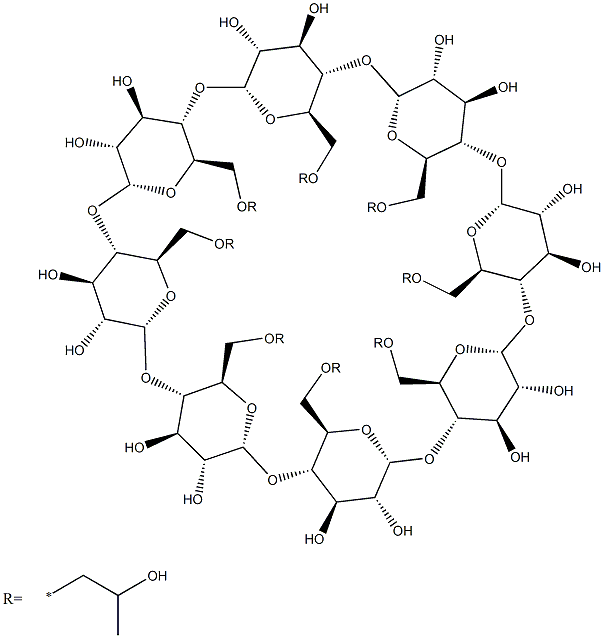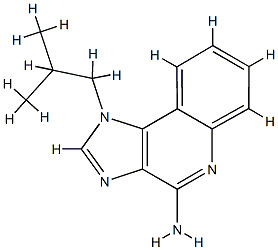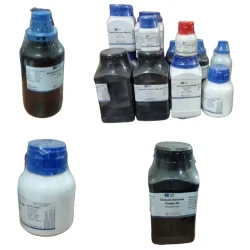2-Hydroxypropyl-β-cyclodextrin
Synonym(s):Beta-cyclodextrin;HP-β-CD;(2-Hydroxypropyl)-beta-cyclodextrin;HP-γ-CD;HGC
- CAS NO.:128446-35-5
- Empirical Formula: C63H112O42
- Molecular Weight: 1541.54
- MDL number: MFCD00069372
- EINECS: 420-920-1
- SAFETY DATA SHEET (SDS)
- Update Date: 2025-12-24 14:33:46

What is 2-Hydroxypropyl-β-cyclodextrin?
Chemical properties
White to slightly yellow powder
Chemical properties
Hydroxypropyl betadex occurs as a white or almost white, amorphous or crystalline powder.
The Uses of 2-Hydroxypropyl-β-cyclodextrin
2-Hydroxypropyl-β-cyclodextrin (HBC) is a widely used modified cyclodextrin, the lipophilic cavity formed by 7 glucose units. Drug solubility in water is greatly enhanced by complexing with 2-Hydroxypropyl-β-cyclodextrin.
The Uses of 2-Hydroxypropyl-β-cyclodextrin
enteric coating, sustained release formulations, buccal and transdermal drug delivery
The Uses of 2-Hydroxypropyl-β-cyclodextrin
2-Hydroxypropyl-β-cyclodextrin can be used as selective estrogen receptor modulator for the prevention of osteoporosis
What are the applications of Application
2-Hydroxypropyl-β-cyclodextrin is a cyclodextrin oligosaccharide that improves the aqueous solubility of various compounds, especially those containing a phenyl group.
Production Methods
Hydroxypropyl betadex is prepared by the treatment of an alkaline solution of b-cyclodextrin with propylene oxide. The substitution pattern can be influenced by varying the pH. Formation of O-6 and O-2 substituted products is favored by high and low alkali concentration, respectively. The mixture of products produced may be refined by preparative chromatography.
General Description
(2-Hydroxypropyl)-β-cyclodextrin, a hydroxyalkyl derivative, finds application as a formulation vehicle that is used to enhance the solubility of the drugs in aqueous solutions for the successful delivery of medical agents to biological systems. It is generally employed as a substitute for α-, β- and γ-cyclodextrins.
Pharmaceutical Applications
Hydroxypropyl betadex has been widely investigated in pharmaceutics
and has principally been used as a solubilizer for
hydrophobic molecules in oral liquids,oral solids, parenterals,
pressurized metered dose inhalers, dry powder inhalers,
and topical formulations. It has also been shown to act as a
stabilizer during processing and storage of formulations.
Hydroxypropyl betadex inclusion complexes have been reported
to show mechanical properties distinct from the pure materials.
The reported advantage of hydroxypropyl betadex over unsubstituted
b-cyclodextrin is its greater water solubility.
Biological Activity
Cell treatment with HPβCD results in the activation of the transcription factor EB, a master regulator of lysosomal function and autophagy, and in the enhancement of the cellular autophagic clearance capacity. HPβCD administration promotes transcription factor EB-mediated clearance of proteolipid aggregates that accumulate due to inefficient activity of the lysosome-autophagy system in cells derived from a patient with a lysosomal storage disorder. Interestingly, HPβCD-mediated activation of autophagy was found not to be associated with activation of apoptotic pathways[2].
Side Effects
2-Hydroxypropyl-β-cyclodextrin (HP-beta-CD) has been shown to be well tolerated in humans, with the main adverse event being diarrhoea and there have been no adverse events on kidney function, documented to date[1].
Safety
The pharmaceutical toxicology of hydroxypropyl betadex has been reviewed, and in general, the material was found to be of low toxicity. It has been suggested that hydroxypropyl betadex may have a synergistic toxic effect with, for example, carcinogens, by increasing their solubility and thus bioavailability.
Storage
Store in well-closed containers.
Regulatory Status
Included in oral and parenteral medicinal products. Included in an injectable preparation licensed in the UK for intramuscular or intravenous administration.
References
[1] Sarah Gould, Robert C. Scott. “2-Hydroxypropyl-β-cyclodextrin (HP-β-CD): A toxicology review.” Food and Chemical Toxicology 43 10 (2005): Pages 1451-1459.
[2] Wensi Song. “2-Hydroxypropyl-β-cyclodextrin promotes transcription factor EB-mediated activation of autophagy: implications for therapy.” The Journal of Biological Chemistry (2014): 10211–22.
Properties of 2-Hydroxypropyl-β-cyclodextrin
| Melting point: | 278 °C (dec.) |
| Boiling point: | 400℃ |
| Density | 1.05 at 20.3℃ |
| refractive index | 125 ° (C=1, H2O) |
| storage temp. | room temp |
| solubility | H2O: 45 % (w/v) |
| form | solution (clear, colorless) |
| color | White to slightly yellow |
| optical activity | [α]26/D +139°, c = 1 in H2O |
| Water Solubility | Soluble in water. |
| EPA Substance Registry System | .beta.-Cyclodextrin, 2-hydroxypropyl ethers (128446-35-5) |
Safety information for 2-Hydroxypropyl-β-cyclodextrin
| Signal word | Warning |
| Pictogram(s) |
 Exclamation Mark Irritant GHS07 |
| GHS Hazard Statements |
H315:Skin corrosion/irritation H319:Serious eye damage/eye irritation H335:Specific target organ toxicity, single exposure;Respiratory tract irritation |
| Precautionary Statement Codes |
P261:Avoid breathing dust/fume/gas/mist/vapours/spray. P280:Wear protective gloves/protective clothing/eye protection/face protection. |
Computed Descriptors for 2-Hydroxypropyl-β-cyclodextrin
| InChIKey | ODLHGICHYURWBS-FOSILIAISA-N |
2-Hydroxypropyl-β-cyclodextrin manufacturer
Vinayak Group
New Products
Indole Methyl Resin tert-butyl 9-methoxy-3-azaspiro[5.5]undecane-3-carboxylate Boc-His(Boc)-OH 2-CTC Resin 4-Chloro-7-tosy1-7Hpyrrolo[2,3-d]pyrimidine 5,7-Dibromo-1H-indole 2,5-dichloro-N-hydroxy-4,6-dimethylpyridine-3-carboximidamide 2,2-Dimethoxy-7-azaspiro[3.5]nonane hydrochloride 4-chloromethyl-5-methyl-1,3-dioxol-2-one (DMDO-Cl) R-2-BENZYLOXY PROPIONIC ACID 1,1’-CARBONYLDIIMIDAZOLE 1,1’-CARBONYLDI (1,2-4 TRIAZOLE) N-METHYL INDAZOLE-3-CARBOXYLIC ACID 4-((2-hydroxyethyl)thio)benzoic acid 1-(TERT-BUTOXYCARBONYL)-2-PYRROLIDINONE Methyl 6-methylnicotinate 3-Pyridineacrylic acid tert-Butyl carbazate TETRAHYDRO-2H-PYRAN-3-OL 2-((4-morpholinophenylamino) (methylthio) methylene) malononitrile 3-(4-morpholinophenylamino)-5-amino-1H-pyrazole-4-carbonitrile 2,4-dihydroxybenzaldehyde 1,3-Diethyl-1,3-Diphenylurea Methyl 2-methylquinoline-6-carboxylateRelated products of tetrahydrofuran








You may like
-
 Hydroxypropyl-B-Cyclodextrin (HPBCD) ExiPlus CAS 128446-35-5View Details
Hydroxypropyl-B-Cyclodextrin (HPBCD) ExiPlus CAS 128446-35-5View Details
128446-35-5 -
 2-Hydroxypropyl-β-cyclodextrin CAS 128446-35-5View Details
2-Hydroxypropyl-β-cyclodextrin CAS 128446-35-5View Details
128446-35-5 -
 2-Hydroxypropyl-β-cyclodextrin CAS 128446-35-5View Details
2-Hydroxypropyl-β-cyclodextrin CAS 128446-35-5View Details
128446-35-5 -
 Hydroxypropyl-β-cyclodextrin CAS 128446-35-5View Details
Hydroxypropyl-β-cyclodextrin CAS 128446-35-5View Details
128446-35-5 -
 Hydroxypropylbetadex 98%+ reference standard grade CAS 128446-35-5View Details
Hydroxypropylbetadex 98%+ reference standard grade CAS 128446-35-5View Details
128446-35-5 -
 (2-Hydroxypropyl)-ß-Cyclodextrin, for cell culture CAS 128446-35-5View Details
(2-Hydroxypropyl)-ß-Cyclodextrin, for cell culture CAS 128446-35-5View Details
128446-35-5 -
 Hydroxypropyl betadex CAS 128446-35-5View Details
Hydroxypropyl betadex CAS 128446-35-5View Details
128446-35-5 -
 25gm 2-HYDROXYPROPYL -B -CYCLODEXTRIN HPBCD 2574View Details
25gm 2-HYDROXYPROPYL -B -CYCLODEXTRIN HPBCD 2574View Details
128446-35-5
